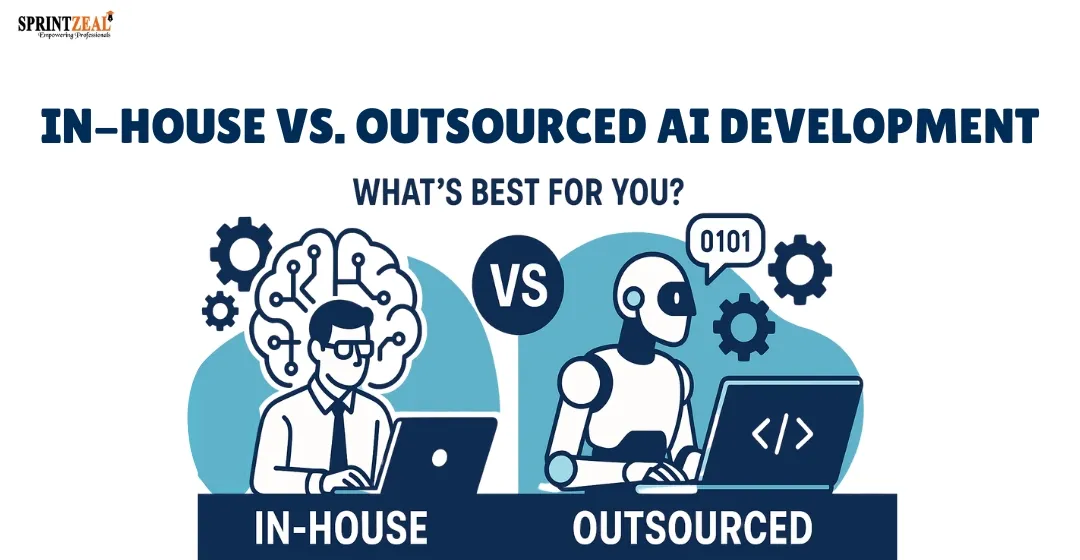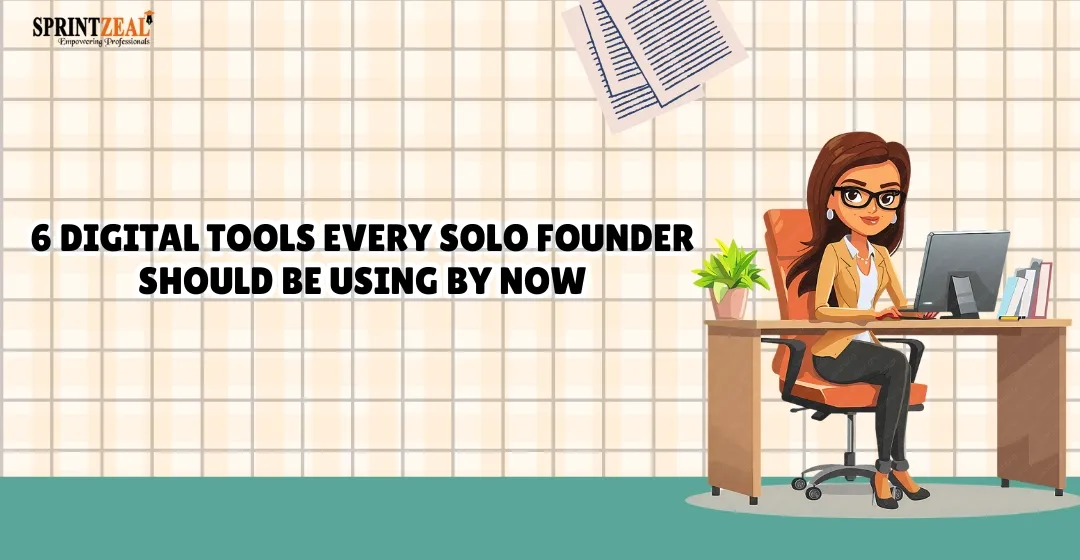Build a Store That Sells: E-commerce Essentials Explained
-
 By Sprintzeal
By Sprintzeal - Published on Apr 29 2025

The U.S. e-Commerce market will reach $6.8 trillion by 2025. This growth makes partnering with the right website development company vital for business success online. Visitors take just 50 milliseconds to judge a website's quality, which shows why professional development matters so much.
Online sales potential remains huge. A business's size and needs to determine its e-commerce website development costs. Small stores selling under 100 products need between $1,000 to $5,000. Larger enterprises should budget over $50,000. New store owners pay around $39 in monthly operational costs. Most small businesses spend 9% of their first-year budget on online operations.
This piece explains everything needed to build a successful online store. Readers will learn about platform selection and design elements that boost sales. The information helps both new ventures and existing businesses that want to grow their online presence.
Table of Contents
Understanding e-Commerce Website Development Costs
Building an e-Commerce store costs more than just the setup fees. Business owners need to understand these expenses to make smart decisions and set the right budget for their online stores.
Breaking Down The Total Investment
Your e-Commerce website's cost depends on what you need. Whether you’re running a dropshipping business or a traditional online store, simplestores using Shopify or WooCommerce start at $500-$3,000. Custom-designed stores with extra features cost $3,000-$10,000. Big enterprise solutions on platforms like Magento can cost over $10,000.
You'll need to pay for domain names ($10-$30 yearly), web hosting ($5-$250 monthly), and SSL certificates ($0-$200 per year). e-Commerce platforms charge $20-$300 monthly for hosted solutions, based on what features you pick.
Design and development take up much of your budget. Ready-made themes cost up to $200, but custom designs range from $2,000 to $20,000+, depending on what you want. Payment gateway fees are a big deal too - they usually take 1% to 4% of each sale plus about $0.30.
Pro Tip: To save money and stick to the budget, choose a hosting provider that offers you the most for less. Hostinger for example has an eCommerce website builder for you to create your online store with all you need to go online: web hosting, domain name and much more integrations under one price.
Factors that Influence Your Budget
Your e-Commerce budget depends on several key choices. The platform you pick is vital - Shopify needs monthly payments, while WooCommerce gives you more control but needs technical know-how.
Website complexity changes everything. Stores with lots of products, smart search options, tricky shipping rules, or multiple languages need bigger budgets. Design costs range from simple templates ($50-$200) to custom designs that cost thousands.
The way you build your site affects the price by a lot. Quick, pre-made solutions cost less, but custom-built websites give you complete freedom at a higher price. Developer rates vary worldwide - from $20-$45 in Africa to $75-$200 in North America.
Adding extra tools is another big cost factor. Payment systems, shipping calculators, CRM systems, marketing tools, and analytics all add up. Let your business size and growth plans guide these choices - you can always add features later.
Hidden Costs to Watch Out For
Surprise expenses catch many store owners off guard. Monthly maintenance and updates run $50-$1,000, covering security fixes, platform updates, and tech support. Security is a huge deal. Beyond SSL certificates, good e-Commerce security measures cost $500-$10,000 yearly. Payment processing fees (2.5-3.5% per transaction) eat into your profits over time.
Marketing costs are often bigger than expected. You'll need money for SEO, social media, email campaigns, and maybe influencer partnerships. Product photos can be expensive if you hire pros.
Legal stuff adds up fast. Business registration ($50-$250), trademarks ($225-$400), and legal documents ($500-$1,000) are must-haves. e-Commerce insurance costs $500-$2,500 yearly.
Managing inventory and shipping brings more expenses. These costs change based on how big your operation gets. Tax software becomes essential as you grow, especially since the South Dakota v. Wayfair ruling made customer location and sales volume key factors in tax obligations.
Look at all these costs carefully before picking a website development company. This helps you plan for both startup and running costs, setting up your e-Commerce business for long-term success.
Choosing the Right e-Commerce Platform
Picking the right e-Commerce platform is like laying the foundation of your house—it shapes how much value your business can get from being online. A solid platform, combined with strategic ecommerce website design, creates a reliable experience for customers, brings in leads naturally, and ends up boosting your ROI.
Self-Hosted VS. SaaS Solutions
You'll face your first big choice between two main hosting models when setting up your online store: self-hosted or Software-as-a-Service (SaaS) solutions. Self-hosted platforms (some call them on-premise) put you in charge of hosting on your servers or through third-party providers. These platforms give you full control over source code and data, so you can customize everything. But this freedom comes with responsibility - you'll have to take care of security, updates, and maintenance yourself.
SaaS platforms are cloud-based solutions that bundle software and hosting into one monthly subscription. Your SaaS provider handles all the technical stuff, from product updates to security, hosting, and PCI compliance. The numbers speak for themselves - the global SaaS market grew to $197 billion in 2023, and there's good reason, too.
Here's what sets these options apart:
- Cost structure - Self-hosted needs more money upfront, but might cost less long-term for some businesses. SaaS keeps things simple with predictable monthly fees.
- Maintenance responsibility - Self-hosted means you're in charge of maintenance, security updates, and compliance. SaaS providers take care of all that for you. That’s why many resellers and digital agencies prefer SaaS-based white label website builder platforms—they offer a plug-and-play experience.
- Customization potential - Self-hosted lets you customize everything if you've got the technical know-how. SaaS is easier to set up but has some limits on what you can change.
- Scalability - SaaS platforms naturally handle traffic spikes, while self-hosted might need extra infrastructure investment as you grow.
Popular Platforms Compared
Several platforms stand out from the crowd based on their reliability, features, and what users say about them. Shopify shines with great e-Commerce design templates and a huge app store that adds features without coding. You can sell through multiple channels like Amazon, Facebook, and eBay. It works especially well when you have a growing business thanks to its easy scaling options.
BigCommerce gives you unlimited product listings with any plan and skips extra transaction fees. Businesses love its powerful SEO tools and B2B features. Unlike its competitors, BigCommerce doesn't put limits on online traffic.
WooCommerce, a WordPress plugin, excels at international selling through multilingual features when paired with plugins like WPML. Its open-source nature means you can customize everything, but you'll need some technical skills.
Magento/Adobe Commerce offers a unique experience by letting users modify every part of the buyer's experience. But this flexibility often means you'll need external developers, which makes total costs harder to predict.
Squarespace Commerce catches eyes with over 100 e-Commerce templates. It handles physical products, digital goods, subscriptions, and services with ease, making it perfect for creative businesses.
Matching Platforms to Business Size
Each business size needs different things from their platform based on complexity, budget, and growth plans. Small businesses just starting need platforms that make things simple. Squarespace has AI-powered tools and ready-made templates to speed up website creation. Shopify's user-friendly design and detailed support help beginners get started.
Fast-growing businesses need platforms that grow with them. Shopify makes it easy to upgrade plans as your business expands and helps quickly when problems pop up. BigCommerce also offers enterprise-level features that become available as you scale up.
At this stage, partnering with an experienced ecommerce app development company can help extend your brand’s presence to mobile platforms and enhance customer engagement.
Enterprise businesses that are well established need platforms with full API access, headless commerce options, and enterprise-grade performance. These companies usually want their platform to work naturally with their CRM, ERP, and automation tools.
The platform you pick depends on what your business needs, your technical skills, and where you're headed. Look beyond the setup costs to things like payment processing, security features, marketing tools, and customer support. A solid foundation now saves you from expensive platform changes as your business grows.
Conclusion
Success in e-Commerce depends on how well you connect different moving parts. Your original costs can vary substantially based on your business size and needs. Smart planning helps you build green practices for your online venture. You need the right platform, core technical elements, and a well-organized product catalog that are the foundations of growth.
Design goes beyond simple functionality. Intuitive navigation, smooth checkout flows, and compelling product displays affect your conversion rates directly. On top of that, it takes robust security and seamless payment options to build trust and keep customers coming back.
Smart decisions about hosting upgrades, ecommerce observability solutions, and automation help your business grow without breaking the bank. The most successful online stores create systems that handle more transactions smoothly. Store owners who focus on everything in their business thrive faster in today's expanding digital world.
Subscribe to our Newsletters
Popular Programs
ISO/IEC 38500 IT Corporate Governance Manager
Live Virtual Training
- 4.4 (650 + Ratings)
- 46k + Learners
ISO/IEC 38500 Lead IT Corporate Governance Manager
Live Virtual Training
- 5 (650 + Ratings)
- 33k + Learners
Trending Posts
Business Analyst Qualifications and Skills in 2024
Last updated on Sep 25 2023
What is MBA in HR: Overview, Scope and Benefits
Last updated on Dec 12 2024
In-House vs. Outsourced AI Development: Finding the Right Balance
Last updated on Jul 24 2025
6 Digital Tools Every Solo Founder Should Be Using by Now
Last updated on Jul 3 2025
5 Best Debt Collection Tools for Faster Payments and Scalable Growth
Last updated on Aug 27 2025
Business Automation: Reshaping Modern Enterprises
Last updated on Mar 11 2025
Categories
- Other 62
- Agile Management 57
- Cloud Computing 50
- Project Management 170
- Big Data 58
- Business Management 79
- Digital Marketing 73
- IT Service Management 29
- Programming Language 47
- AI and Machine Learning 67
- IT Security 108
- Quality Management 77
- IT Hardware and Networking 25
- Microsoft Program 4
- Workplace Skill Building 11
- Risk Management 9
- Information Security 8
- Leadership and Management 7
- Corporate Training and Development 1
Trending Now
Process Maps - How to Create and Use Them
ebook11 Best Business Blogs 2024 (UPDATED)
ebookCBAP Certification Exam Preparation Guide 2024
ebookBusiness analyst career path in 2024
ebookCCBA Certification Career Transformation Guide
ebookUpdated Business Analyst Interview Questions and Answers 2024
ebookTop Salesforce Interview Questions and Answers 2024
ebookWhat Is Business Continuity Planning?
ebookBusiness Analysis Certifications 2024
ebookBusiness Process Mapping Guide for Beginners
ebookBusiness Analyst Skills List 2024
ebookWhat is Business Analysis - A Complete Guide
ebookRemote Working Methods for 2024
ebookBest Business Analytics Tools in 2024
ebookWhat is Salesforce? A Beginner's Guide
ebookWhat is Digital Business? An Introduction
ebookBusiness Analyst Job Requirements - Qualifications and Skills
ebookBusiness Analyst Job Profile – Role, Skills and Challenges
ebookTypes of Business Analyst Roles in 2024 – Responsibilities and Earnings
ebookBusiness Analyst Qualifications and Skills in 2024
ebookBusiness Analyst Career Road Map Explained
ebookHow to Become a Business Analyst: Step-by-Step Guide
ArticleBusiness Analyst Job Description - Key Role and Responsibilities
ebookBusiness Analyst Career Guide 2023
ebookWhy Become a Business Analyst in 2023: Top Reasons and Scope
ArticleFundamentals of Business Impact Analysis (BIA): Best Practices to Implement
ArticleBenefits of ISO 26000 for Strengthening Business Continuity
ebookThe Essential Guide to ISO Standards in Business Management
ArticlePrinciples of ISO 14001 Foundation
ArticleUnderstanding ISO/IEC 38500 IT Foundation and its application
ArticleTop Professional Business Certifications Trending in 2025
ArticleSteps to Implementing ISO 22301 Foundation: A Complete Guide
ebookUnderstanding ISO 37101 Foundation and Its Role in Sustainable Development
Article7 Core Principles of ISO 26000: A Guide to Ethical Organizational Practices
ebookThe Reason For The Fall Of BlackBerry
ArticleGoogle and Innovation: What Makes it Most Innovative?
ArticleBest Business Analysis Books You Need to Read in 2025
ArticleWhat is MBA in HR: Overview, Scope and Benefits
ArticleHow to Become a Product Manager: A Step-by-Step Guide
ArticleWhy Reliance Industries is a Global Giant?
ArticleTata Growth and Global Success: Best Lessons and Their Impact
ArticleMost Sold Ford Car: Global Rankings and Success Insights
ArticleHow Disney's Success Story Became a Global Entertainment Powerhouse?
Article4 Proven Approches to Build a Strong LinkedIn Community
ArticleEssential Business Tools Every Female Founder Should Have
ArticleThe Role of Technology in Scaling a Small Business
ArticleMastering Student Finances with AI: The Ultimate Guide for Comfortable Living
ArticleBusiness Automation: Reshaping Modern Enterprises
ArticleThe ROI of Automated Invoice Processing: What Can Your Company Save?
ArticleCareer Opportunities After a Distance MBA in India
ArticleModeling Business Processes in Law Firms: Optimization Through Modern Technologies
ArticleBoosting E-Learning Visibility with SEO and Video Translation Strategies
ArticleMaximizing E-Commerce Efficiency: Top Plugins Every Online Store Needs
ArticleMastering Digital Communication: Tools That Redefine Transparency in Teams
ArticleWhat Is HubSpot CRM & Why Should You Choose It For Your Business?
ArticleHow Does Personalization Impact Cold Email Success?
ArticleThe 5 Best Lead Finder Tools for Brand Collaborations
ArticleThe Complete Guide to Bootstrapping Your SaaS
ArticleHow to Build a One-Person Business Like a Team of Ten? Bloggervoice
ArticleMaximize ROI: Why Quality Video Animation Services Matter
Article6 Digital Tools Every Solo Founder Should Be Using by Now
ArticleHandle Sales, Tax, and Inventory Seamlessly with Billing Software for PC
ArticleTax Saving Options for Working Individuals in 2025
ArticleHow to Use AI Video Generators and Online Video Translators to Grow an International Audience
ArticleBest Accounting Software For Etsy Bookkeeping
ArticleOutsourcing: Everything You Need to Know
ArticleIn-House vs. Outsourced AI Development: Finding the Right Balance
ArticleAffordable Asset Management Software for Small Teams
ArticleFrom Delays to Instant Approvals: The Power of Real-Time Insurance in Labs
Article3 Best Video Meeting Tools to Simplify Remote Work and Hybrid Teams
Article5 Top Accounting Software Options for Construction Firms
Article5 Best Debt Collection Tools for Faster Payments and Scalable Growth
ArticleWhy Manufacturers Should Invest in Both Machines and People
ArticleMBA Interview Questions and Answers Guide 2025
ArticleTop 7 Tools for WhatsApp And HubSpot Integration in 2025
ArticleThe Future of Networking and CRM: Building Stronger Business Connections
ArticleThe Best 3D Architectural Rendering Companies
ArticleMastering the Art of Interpersonal Communication
Article






+Foundation.webp)










